BSBSUS401: Environmental Sustainability in the Workplace Assignment
VerifiedAdded on 2021/12/29
|14
|3007
|24
Homework Assignment
AI Summary
This BSBSUS401 assignment delves into the significance of environmentally sustainable work practices, covering legislation, programs, and various aspects of sustainability within the workplace. It explores topics such as the importance of sustainability, relevant environmental legislation, and the Green Globe Program. The assignment includes descriptions of analysis tools like audits, benchmarking, and checklists. It also investigates information sources for efficiency, communication strategies for environmental sustainability, and factors for measuring the efficacy of resources such as energy, goods, and waste. The assignment examines efficiency ratings for appliances, recommendations from the World Travel and Tourism Council (WTTC) Green Globe Program, and examples of environmental impacts. It provides suggestions for improving water and energy usage, examples of renewable energy, and discusses the impacts of waste on the environment. The assignment also lists common causes of waste, policies for waste reduction, hazardous substances, and ways to improve land use and building design. It outlines steps to initiate an Environmental Management Plan, defines the role of a "Green team," and describes processes for identifying consumption of energy, gas, or water. The assignment also covers waste audit procedures, benchmarking information, efficiency targets using the SMART principle, staff involvement in sustainability, and actions for non-compliant behavior.
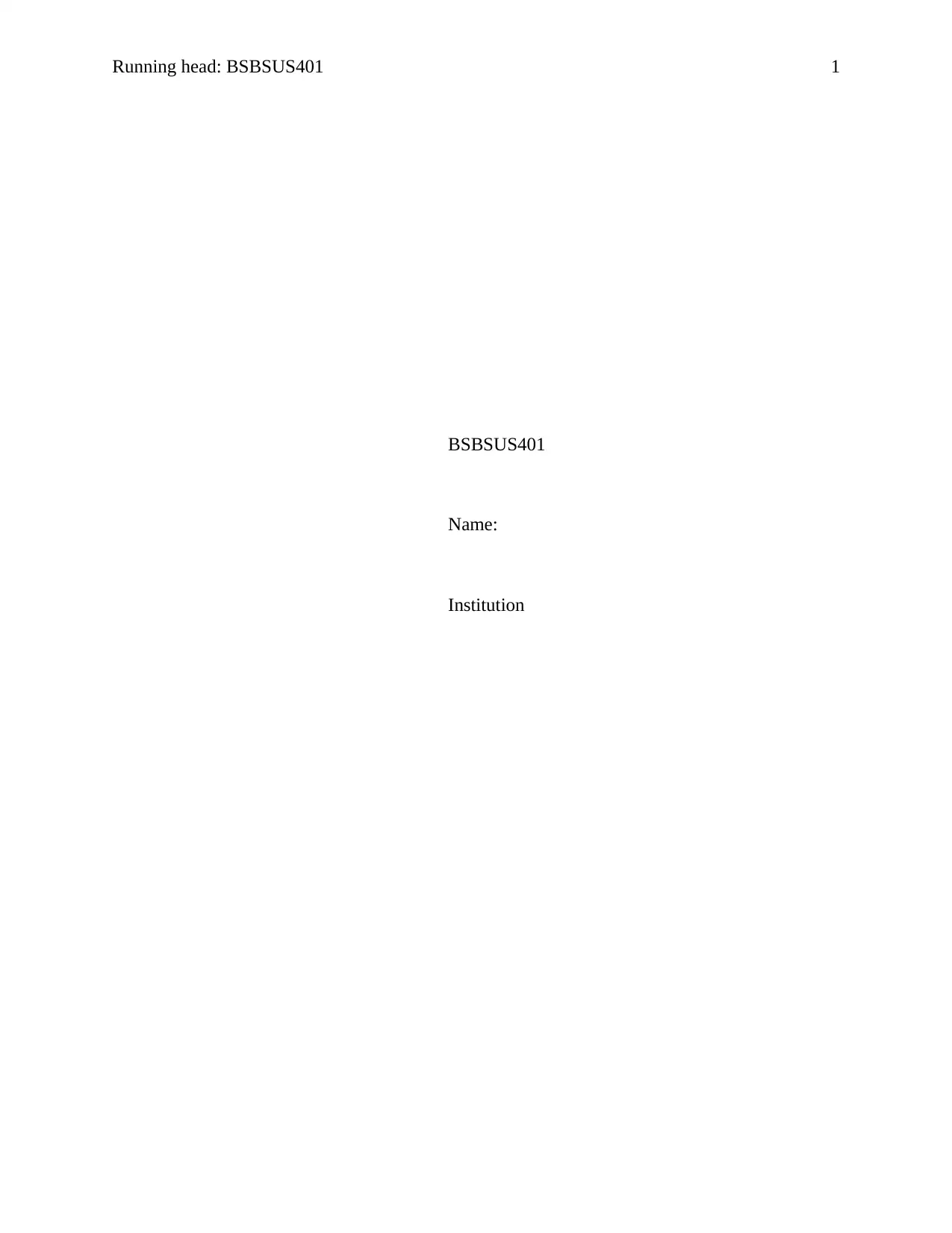
Running head: BSBSUS401 1
BSBSUS401
Name:
Institution
BSBSUS401
Name:
Institution
Paraphrase This Document
Need a fresh take? Get an instant paraphrase of this document with our AI Paraphraser
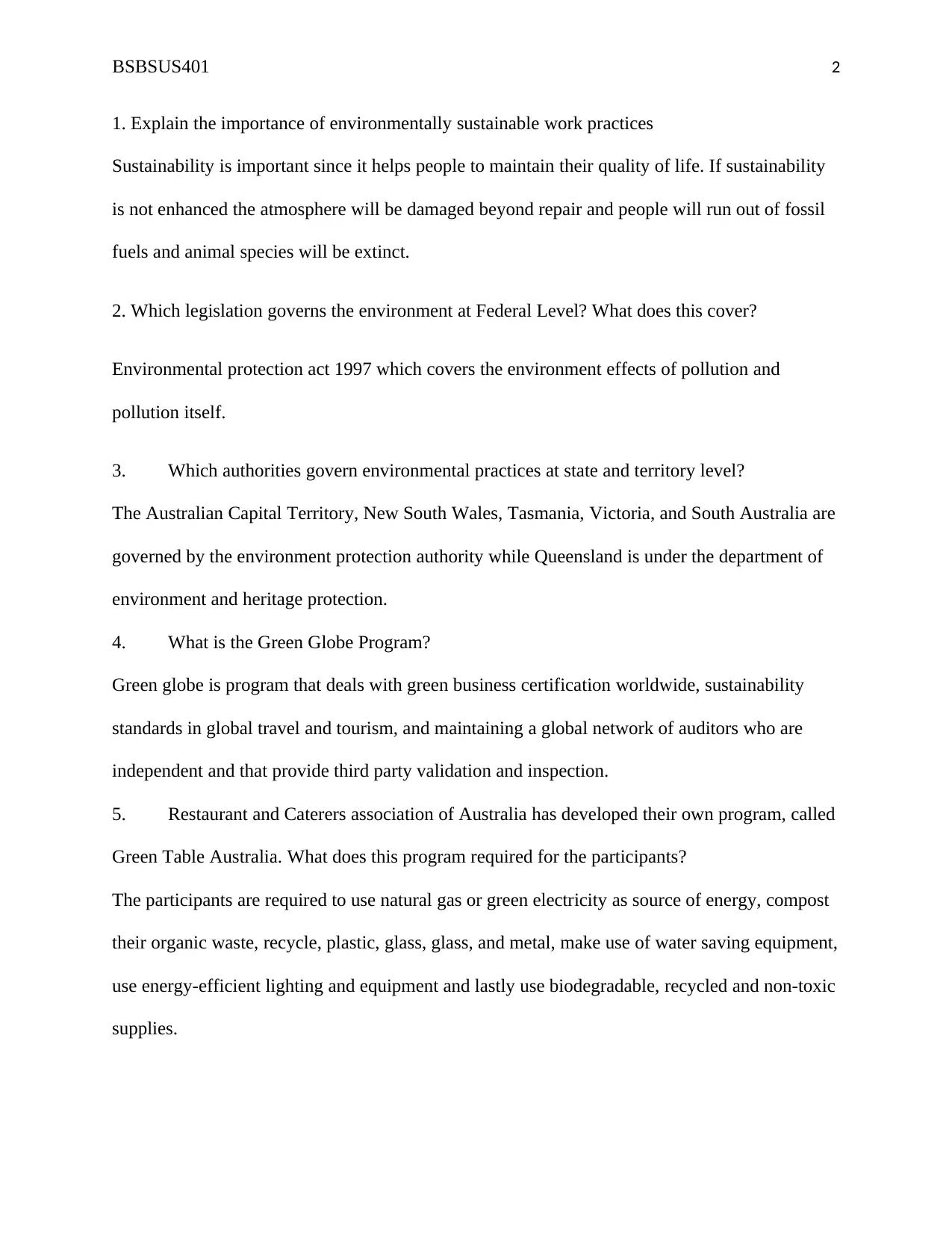
BSBSUS401 2
1. Explain the importance of environmentally sustainable work practices
Sustainability is important since it helps people to maintain their quality of life. If sustainability
is not enhanced the atmosphere will be damaged beyond repair and people will run out of fossil
fuels and animal species will be extinct.
2. Which legislation governs the environment at Federal Level? What does this cover?
Environmental protection act 1997 which covers the environment effects of pollution and
pollution itself.
3. Which authorities govern environmental practices at state and territory level?
The Australian Capital Territory, New South Wales, Tasmania, Victoria, and South Australia are
governed by the environment protection authority while Queensland is under the department of
environment and heritage protection.
4. What is the Green Globe Program?
Green globe is program that deals with green business certification worldwide, sustainability
standards in global travel and tourism, and maintaining a global network of auditors who are
independent and that provide third party validation and inspection.
5. Restaurant and Caterers association of Australia has developed their own program, called
Green Table Australia. What does this program required for the participants?
The participants are required to use natural gas or green electricity as source of energy, compost
their organic waste, recycle, plastic, glass, glass, and metal, make use of water saving equipment,
use energy-efficient lighting and equipment and lastly use biodegradable, recycled and non-toxic
supplies.
1. Explain the importance of environmentally sustainable work practices
Sustainability is important since it helps people to maintain their quality of life. If sustainability
is not enhanced the atmosphere will be damaged beyond repair and people will run out of fossil
fuels and animal species will be extinct.
2. Which legislation governs the environment at Federal Level? What does this cover?
Environmental protection act 1997 which covers the environment effects of pollution and
pollution itself.
3. Which authorities govern environmental practices at state and territory level?
The Australian Capital Territory, New South Wales, Tasmania, Victoria, and South Australia are
governed by the environment protection authority while Queensland is under the department of
environment and heritage protection.
4. What is the Green Globe Program?
Green globe is program that deals with green business certification worldwide, sustainability
standards in global travel and tourism, and maintaining a global network of auditors who are
independent and that provide third party validation and inspection.
5. Restaurant and Caterers association of Australia has developed their own program, called
Green Table Australia. What does this program required for the participants?
The participants are required to use natural gas or green electricity as source of energy, compost
their organic waste, recycle, plastic, glass, glass, and metal, make use of water saving equipment,
use energy-efficient lighting and equipment and lastly use biodegradable, recycled and non-toxic
supplies.

BSBSUS401 3
6. What type of information could you obtain from the sustainable tourism cooperative
research centre? (STCRC)
Since there are any tourist activities in Australia, I will be able to know the impact of tourist on
the environment I am located. I will know the sustainable practices that are associated with water
use and waste water production in order to plan for the current tourist (Delmas & Pekovic, 2013).
In the Western Australia parks, forest and marine parks, I can assess the economic value that
comes from the tourism and recreation.
7. Give a description for each analysis tool:
Audits
Audit analysis tool is used in capturing data so that departments that deals with auditing can
undertake audit projects which include document audit. Audit tools improve accuracy in the
audit process.
Benchmarking
It is an analysis tool that measures the performance of a firm’s services and goods or processes
against another company which is considered best in the industry in order to identify
opportunities for improvements.
Checklists
This analysis tool is used in determining the risks that are involved in specific project
management plan (Szeto, Wang & Wong, 2014). It is developed based on the knowledge
gathered from the previous projects that same to the current one.
6. What type of information could you obtain from the sustainable tourism cooperative
research centre? (STCRC)
Since there are any tourist activities in Australia, I will be able to know the impact of tourist on
the environment I am located. I will know the sustainable practices that are associated with water
use and waste water production in order to plan for the current tourist (Delmas & Pekovic, 2013).
In the Western Australia parks, forest and marine parks, I can assess the economic value that
comes from the tourism and recreation.
7. Give a description for each analysis tool:
Audits
Audit analysis tool is used in capturing data so that departments that deals with auditing can
undertake audit projects which include document audit. Audit tools improve accuracy in the
audit process.
Benchmarking
It is an analysis tool that measures the performance of a firm’s services and goods or processes
against another company which is considered best in the industry in order to identify
opportunities for improvements.
Checklists
This analysis tool is used in determining the risks that are involved in specific project
management plan (Szeto, Wang & Wong, 2014). It is developed based on the knowledge
gathered from the previous projects that same to the current one.
⊘ This is a preview!⊘
Do you want full access?
Subscribe today to unlock all pages.

Trusted by 1+ million students worldwide
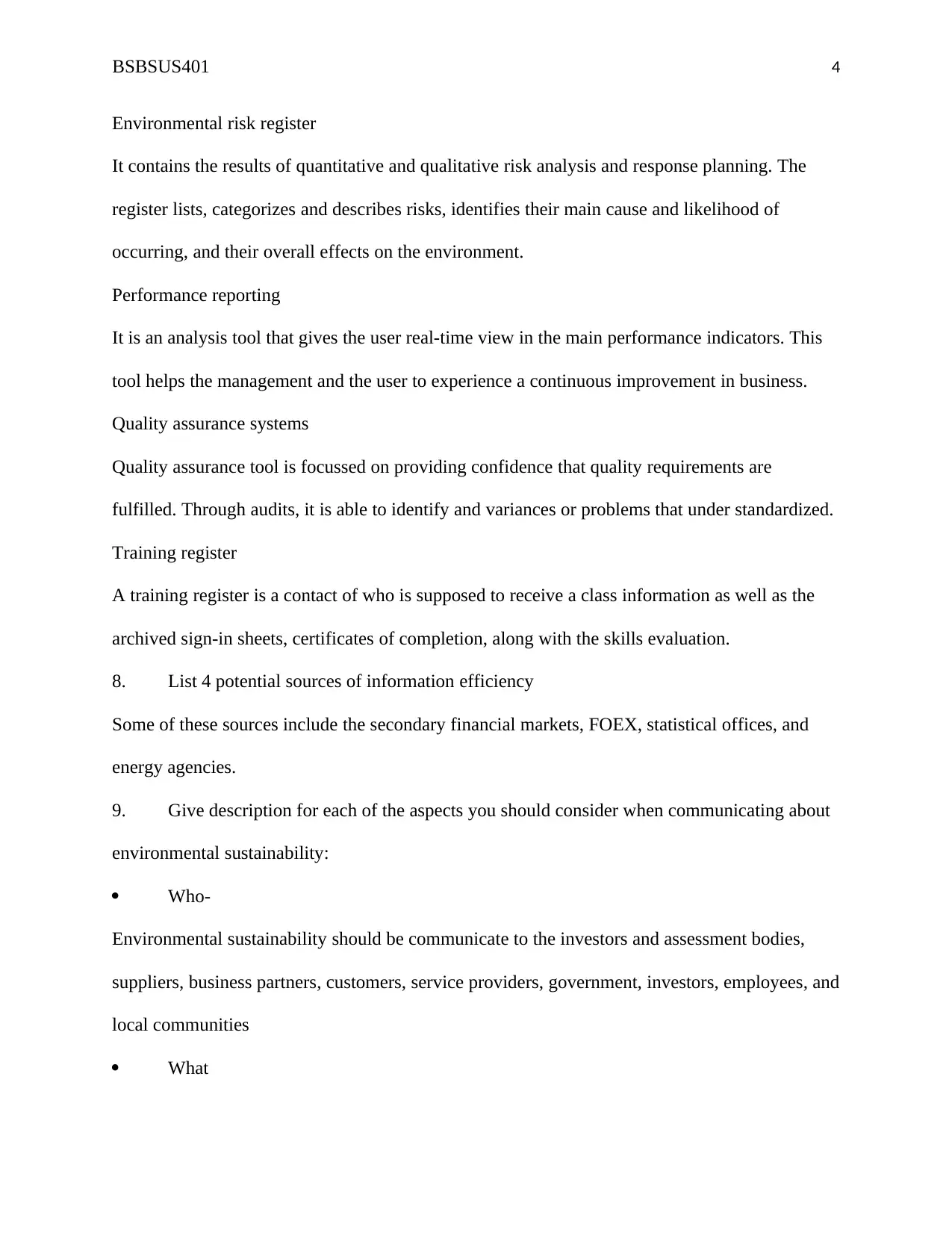
BSBSUS401 4
Environmental risk register
It contains the results of quantitative and qualitative risk analysis and response planning. The
register lists, categorizes and describes risks, identifies their main cause and likelihood of
occurring, and their overall effects on the environment.
Performance reporting
It is an analysis tool that gives the user real-time view in the main performance indicators. This
tool helps the management and the user to experience a continuous improvement in business.
Quality assurance systems
Quality assurance tool is focussed on providing confidence that quality requirements are
fulfilled. Through audits, it is able to identify and variances or problems that under standardized.
Training register
A training register is a contact of who is supposed to receive a class information as well as the
archived sign-in sheets, certificates of completion, along with the skills evaluation.
8. List 4 potential sources of information efficiency
Some of these sources include the secondary financial markets, FOEX, statistical offices, and
energy agencies.
9. Give description for each of the aspects you should consider when communicating about
environmental sustainability:
Who-
Environmental sustainability should be communicate to the investors and assessment bodies,
suppliers, business partners, customers, service providers, government, investors, employees, and
local communities
What
Environmental risk register
It contains the results of quantitative and qualitative risk analysis and response planning. The
register lists, categorizes and describes risks, identifies their main cause and likelihood of
occurring, and their overall effects on the environment.
Performance reporting
It is an analysis tool that gives the user real-time view in the main performance indicators. This
tool helps the management and the user to experience a continuous improvement in business.
Quality assurance systems
Quality assurance tool is focussed on providing confidence that quality requirements are
fulfilled. Through audits, it is able to identify and variances or problems that under standardized.
Training register
A training register is a contact of who is supposed to receive a class information as well as the
archived sign-in sheets, certificates of completion, along with the skills evaluation.
8. List 4 potential sources of information efficiency
Some of these sources include the secondary financial markets, FOEX, statistical offices, and
energy agencies.
9. Give description for each of the aspects you should consider when communicating about
environmental sustainability:
Who-
Environmental sustainability should be communicate to the investors and assessment bodies,
suppliers, business partners, customers, service providers, government, investors, employees, and
local communities
What
Paraphrase This Document
Need a fresh take? Get an instant paraphrase of this document with our AI Paraphraser
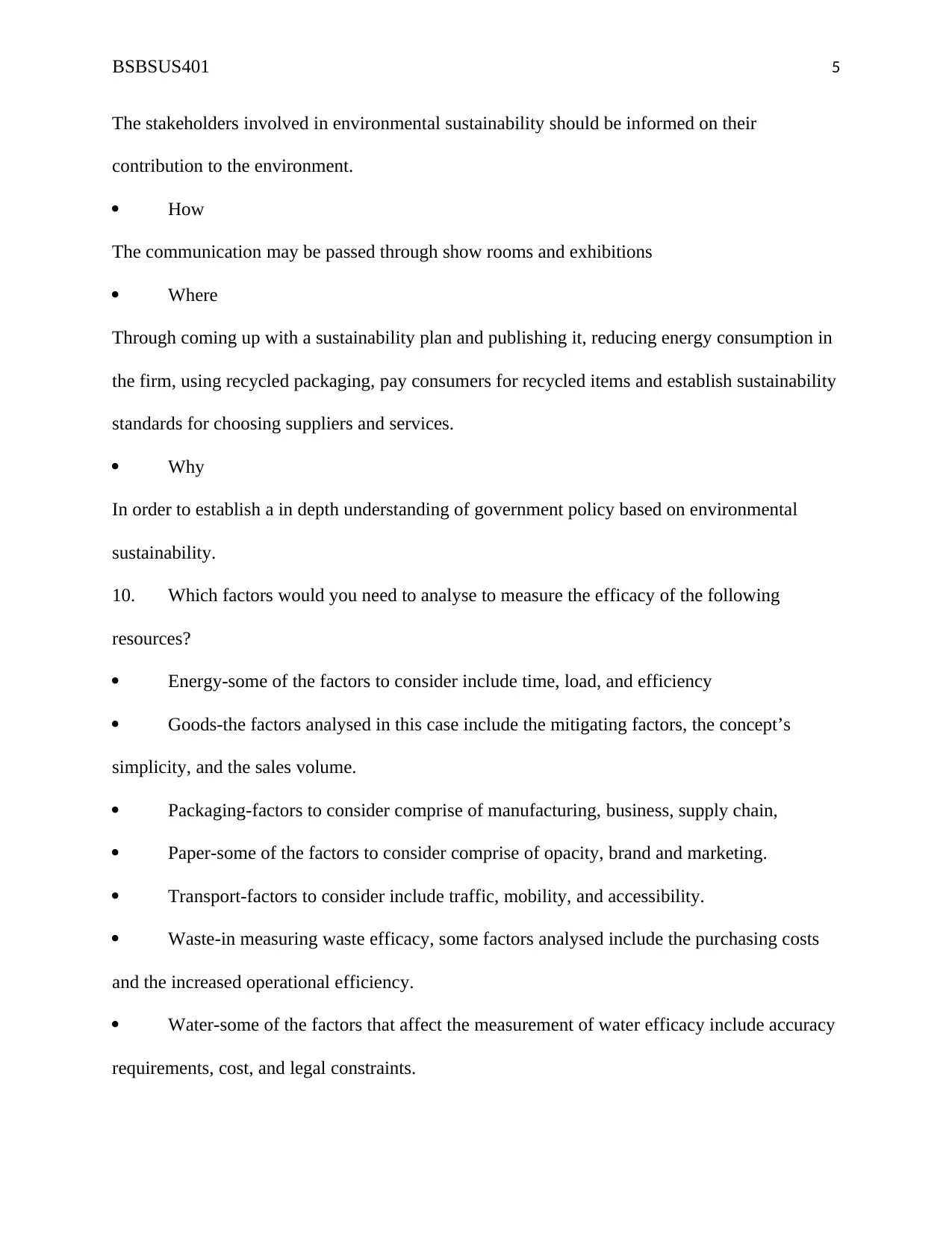
BSBSUS401 5
The stakeholders involved in environmental sustainability should be informed on their
contribution to the environment.
How
The communication may be passed through show rooms and exhibitions
Where
Through coming up with a sustainability plan and publishing it, reducing energy consumption in
the firm, using recycled packaging, pay consumers for recycled items and establish sustainability
standards for choosing suppliers and services.
Why
In order to establish a in depth understanding of government policy based on environmental
sustainability.
10. Which factors would you need to analyse to measure the efficacy of the following
resources?
Energy-some of the factors to consider include time, load, and efficiency
Goods-the factors analysed in this case include the mitigating factors, the concept’s
simplicity, and the sales volume.
Packaging-factors to consider comprise of manufacturing, business, supply chain,
Paper-some of the factors to consider comprise of opacity, brand and marketing.
Transport-factors to consider include traffic, mobility, and accessibility.
Waste-in measuring waste efficacy, some factors analysed include the purchasing costs
and the increased operational efficiency.
Water-some of the factors that affect the measurement of water efficacy include accuracy
requirements, cost, and legal constraints.
The stakeholders involved in environmental sustainability should be informed on their
contribution to the environment.
How
The communication may be passed through show rooms and exhibitions
Where
Through coming up with a sustainability plan and publishing it, reducing energy consumption in
the firm, using recycled packaging, pay consumers for recycled items and establish sustainability
standards for choosing suppliers and services.
Why
In order to establish a in depth understanding of government policy based on environmental
sustainability.
10. Which factors would you need to analyse to measure the efficacy of the following
resources?
Energy-some of the factors to consider include time, load, and efficiency
Goods-the factors analysed in this case include the mitigating factors, the concept’s
simplicity, and the sales volume.
Packaging-factors to consider comprise of manufacturing, business, supply chain,
Paper-some of the factors to consider comprise of opacity, brand and marketing.
Transport-factors to consider include traffic, mobility, and accessibility.
Waste-in measuring waste efficacy, some factors analysed include the purchasing costs
and the increased operational efficiency.
Water-some of the factors that affect the measurement of water efficacy include accuracy
requirements, cost, and legal constraints.
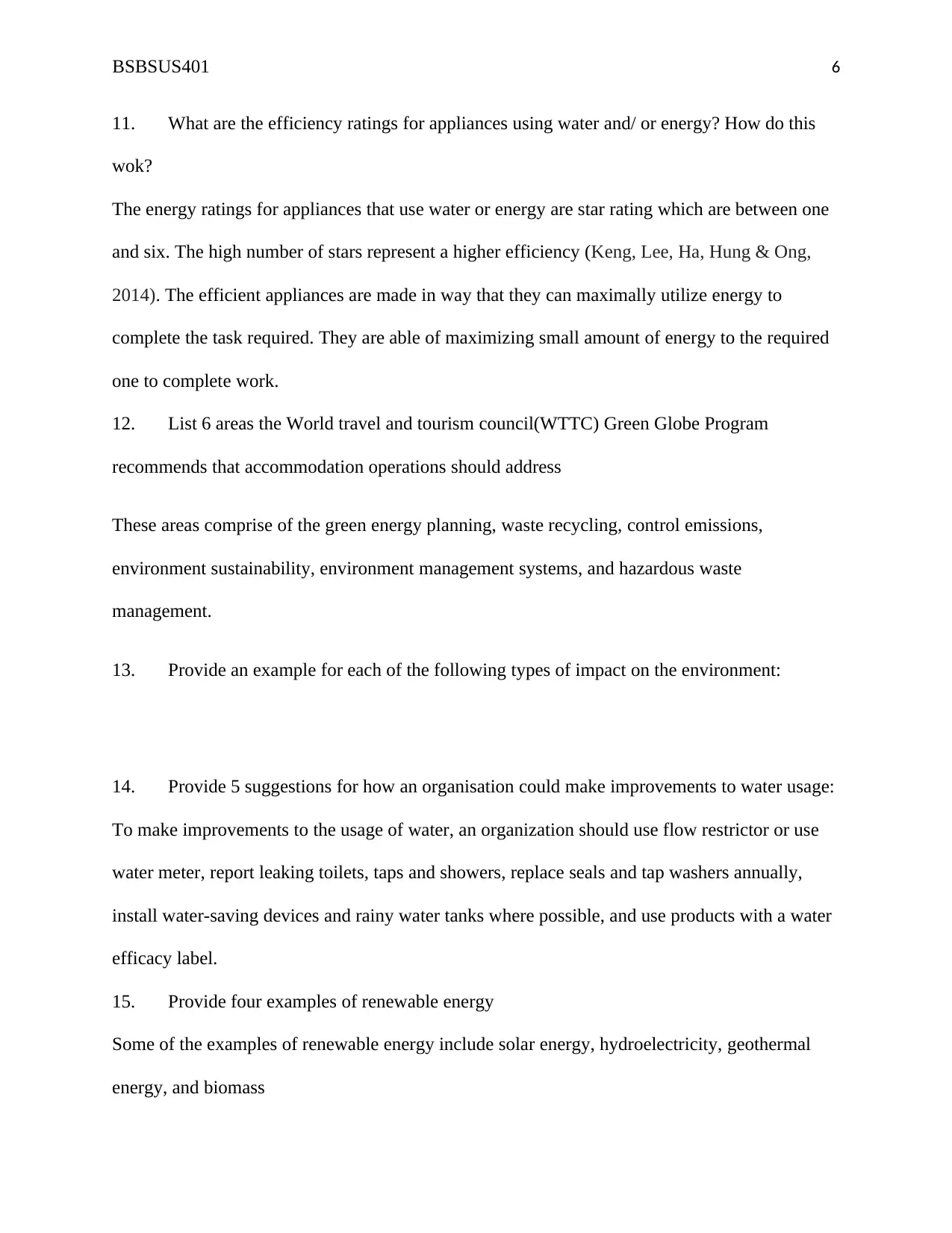
BSBSUS401 6
11. What are the efficiency ratings for appliances using water and/ or energy? How do this
wok?
The energy ratings for appliances that use water or energy are star rating which are between one
and six. The high number of stars represent a higher efficiency (Keng, Lee, Ha, Hung & Ong,
2014). The efficient appliances are made in way that they can maximally utilize energy to
complete the task required. They are able of maximizing small amount of energy to the required
one to complete work.
12. List 6 areas the World travel and tourism council(WTTC) Green Globe Program
recommends that accommodation operations should address
These areas comprise of the green energy planning, waste recycling, control emissions,
environment sustainability, environment management systems, and hazardous waste
management.
13. Provide an example for each of the following types of impact on the environment:
14. Provide 5 suggestions for how an organisation could make improvements to water usage:
To make improvements to the usage of water, an organization should use flow restrictor or use
water meter, report leaking toilets, taps and showers, replace seals and tap washers annually,
install water-saving devices and rainy water tanks where possible, and use products with a water
efficacy label.
15. Provide four examples of renewable energy
Some of the examples of renewable energy include solar energy, hydroelectricity, geothermal
energy, and biomass
11. What are the efficiency ratings for appliances using water and/ or energy? How do this
wok?
The energy ratings for appliances that use water or energy are star rating which are between one
and six. The high number of stars represent a higher efficiency (Keng, Lee, Ha, Hung & Ong,
2014). The efficient appliances are made in way that they can maximally utilize energy to
complete the task required. They are able of maximizing small amount of energy to the required
one to complete work.
12. List 6 areas the World travel and tourism council(WTTC) Green Globe Program
recommends that accommodation operations should address
These areas comprise of the green energy planning, waste recycling, control emissions,
environment sustainability, environment management systems, and hazardous waste
management.
13. Provide an example for each of the following types of impact on the environment:
14. Provide 5 suggestions for how an organisation could make improvements to water usage:
To make improvements to the usage of water, an organization should use flow restrictor or use
water meter, report leaking toilets, taps and showers, replace seals and tap washers annually,
install water-saving devices and rainy water tanks where possible, and use products with a water
efficacy label.
15. Provide four examples of renewable energy
Some of the examples of renewable energy include solar energy, hydroelectricity, geothermal
energy, and biomass
⊘ This is a preview!⊘
Do you want full access?
Subscribe today to unlock all pages.

Trusted by 1+ million students worldwide
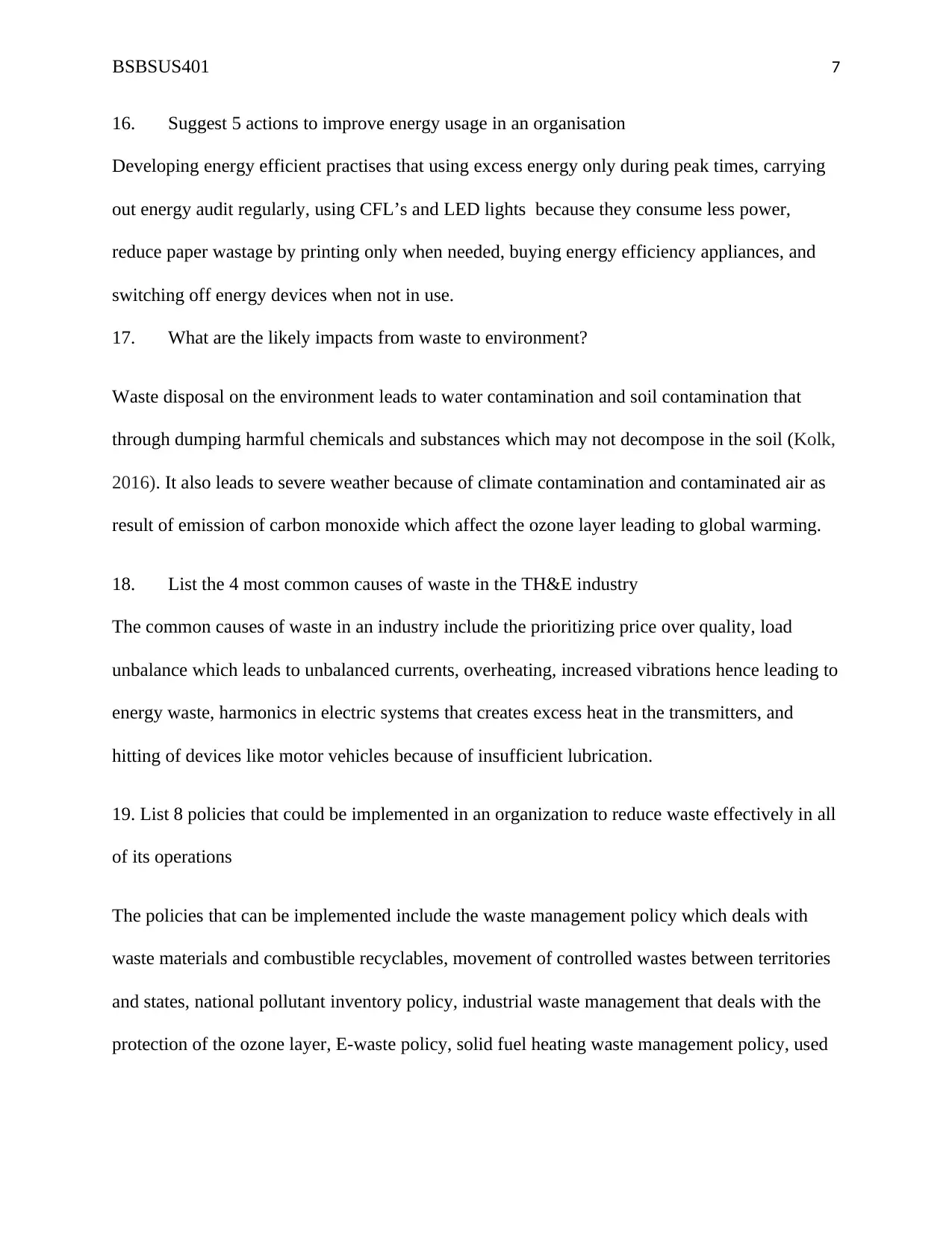
BSBSUS401 7
16. Suggest 5 actions to improve energy usage in an organisation
Developing energy efficient practises that using excess energy only during peak times, carrying
out energy audit regularly, using CFL’s and LED lights because they consume less power,
reduce paper wastage by printing only when needed, buying energy efficiency appliances, and
switching off energy devices when not in use.
17. What are the likely impacts from waste to environment?
Waste disposal on the environment leads to water contamination and soil contamination that
through dumping harmful chemicals and substances which may not decompose in the soil (Kolk,
2016). It also leads to severe weather because of climate contamination and contaminated air as
result of emission of carbon monoxide which affect the ozone layer leading to global warming.
18. List the 4 most common causes of waste in the TH&E industry
The common causes of waste in an industry include the prioritizing price over quality, load
unbalance which leads to unbalanced currents, overheating, increased vibrations hence leading to
energy waste, harmonics in electric systems that creates excess heat in the transmitters, and
hitting of devices like motor vehicles because of insufficient lubrication.
19. List 8 policies that could be implemented in an organization to reduce waste effectively in all
of its operations
The policies that can be implemented include the waste management policy which deals with
waste materials and combustible recyclables, movement of controlled wastes between territories
and states, national pollutant inventory policy, industrial waste management that deals with the
protection of the ozone layer, E-waste policy, solid fuel heating waste management policy, used
16. Suggest 5 actions to improve energy usage in an organisation
Developing energy efficient practises that using excess energy only during peak times, carrying
out energy audit regularly, using CFL’s and LED lights because they consume less power,
reduce paper wastage by printing only when needed, buying energy efficiency appliances, and
switching off energy devices when not in use.
17. What are the likely impacts from waste to environment?
Waste disposal on the environment leads to water contamination and soil contamination that
through dumping harmful chemicals and substances which may not decompose in the soil (Kolk,
2016). It also leads to severe weather because of climate contamination and contaminated air as
result of emission of carbon monoxide which affect the ozone layer leading to global warming.
18. List the 4 most common causes of waste in the TH&E industry
The common causes of waste in an industry include the prioritizing price over quality, load
unbalance which leads to unbalanced currents, overheating, increased vibrations hence leading to
energy waste, harmonics in electric systems that creates excess heat in the transmitters, and
hitting of devices like motor vehicles because of insufficient lubrication.
19. List 8 policies that could be implemented in an organization to reduce waste effectively in all
of its operations
The policies that can be implemented include the waste management policy which deals with
waste materials and combustible recyclables, movement of controlled wastes between territories
and states, national pollutant inventory policy, industrial waste management that deals with the
protection of the ozone layer, E-waste policy, solid fuel heating waste management policy, used
Paraphrase This Document
Need a fresh take? Get an instant paraphrase of this document with our AI Paraphraser
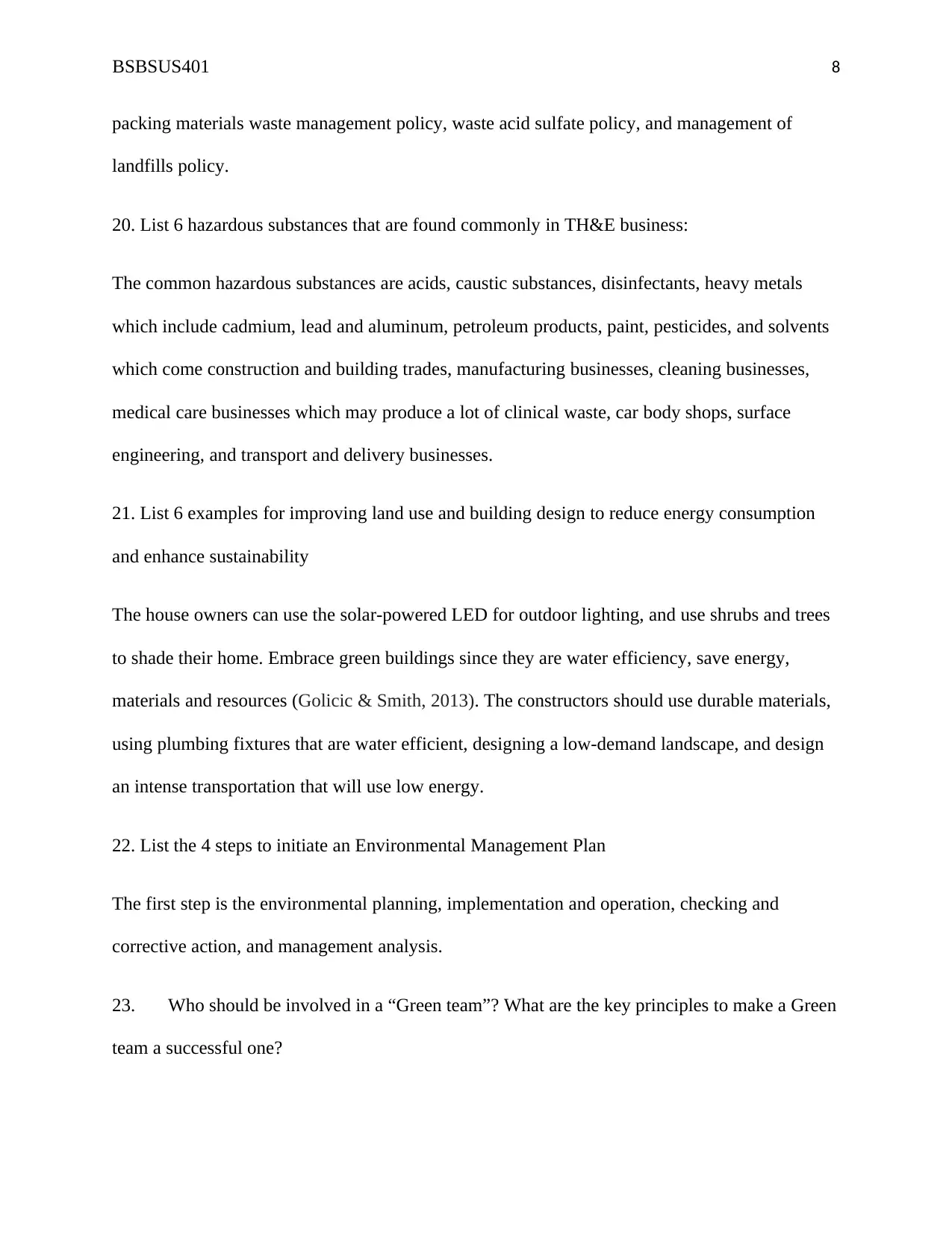
BSBSUS401 8
packing materials waste management policy, waste acid sulfate policy, and management of
landfills policy.
20. List 6 hazardous substances that are found commonly in TH&E business:
The common hazardous substances are acids, caustic substances, disinfectants, heavy metals
which include cadmium, lead and aluminum, petroleum products, paint, pesticides, and solvents
which come construction and building trades, manufacturing businesses, cleaning businesses,
medical care businesses which may produce a lot of clinical waste, car body shops, surface
engineering, and transport and delivery businesses.
21. List 6 examples for improving land use and building design to reduce energy consumption
and enhance sustainability
The house owners can use the solar-powered LED for outdoor lighting, and use shrubs and trees
to shade their home. Embrace green buildings since they are water efficiency, save energy,
materials and resources (Golicic & Smith, 2013). The constructors should use durable materials,
using plumbing fixtures that are water efficient, designing a low-demand landscape, and design
an intense transportation that will use low energy.
22. List the 4 steps to initiate an Environmental Management Plan
The first step is the environmental planning, implementation and operation, checking and
corrective action, and management analysis.
23. Who should be involved in a “Green team”? What are the key principles to make a Green
team a successful one?
packing materials waste management policy, waste acid sulfate policy, and management of
landfills policy.
20. List 6 hazardous substances that are found commonly in TH&E business:
The common hazardous substances are acids, caustic substances, disinfectants, heavy metals
which include cadmium, lead and aluminum, petroleum products, paint, pesticides, and solvents
which come construction and building trades, manufacturing businesses, cleaning businesses,
medical care businesses which may produce a lot of clinical waste, car body shops, surface
engineering, and transport and delivery businesses.
21. List 6 examples for improving land use and building design to reduce energy consumption
and enhance sustainability
The house owners can use the solar-powered LED for outdoor lighting, and use shrubs and trees
to shade their home. Embrace green buildings since they are water efficiency, save energy,
materials and resources (Golicic & Smith, 2013). The constructors should use durable materials,
using plumbing fixtures that are water efficient, designing a low-demand landscape, and design
an intense transportation that will use low energy.
22. List the 4 steps to initiate an Environmental Management Plan
The first step is the environmental planning, implementation and operation, checking and
corrective action, and management analysis.
23. Who should be involved in a “Green team”? What are the key principles to make a Green
team a successful one?
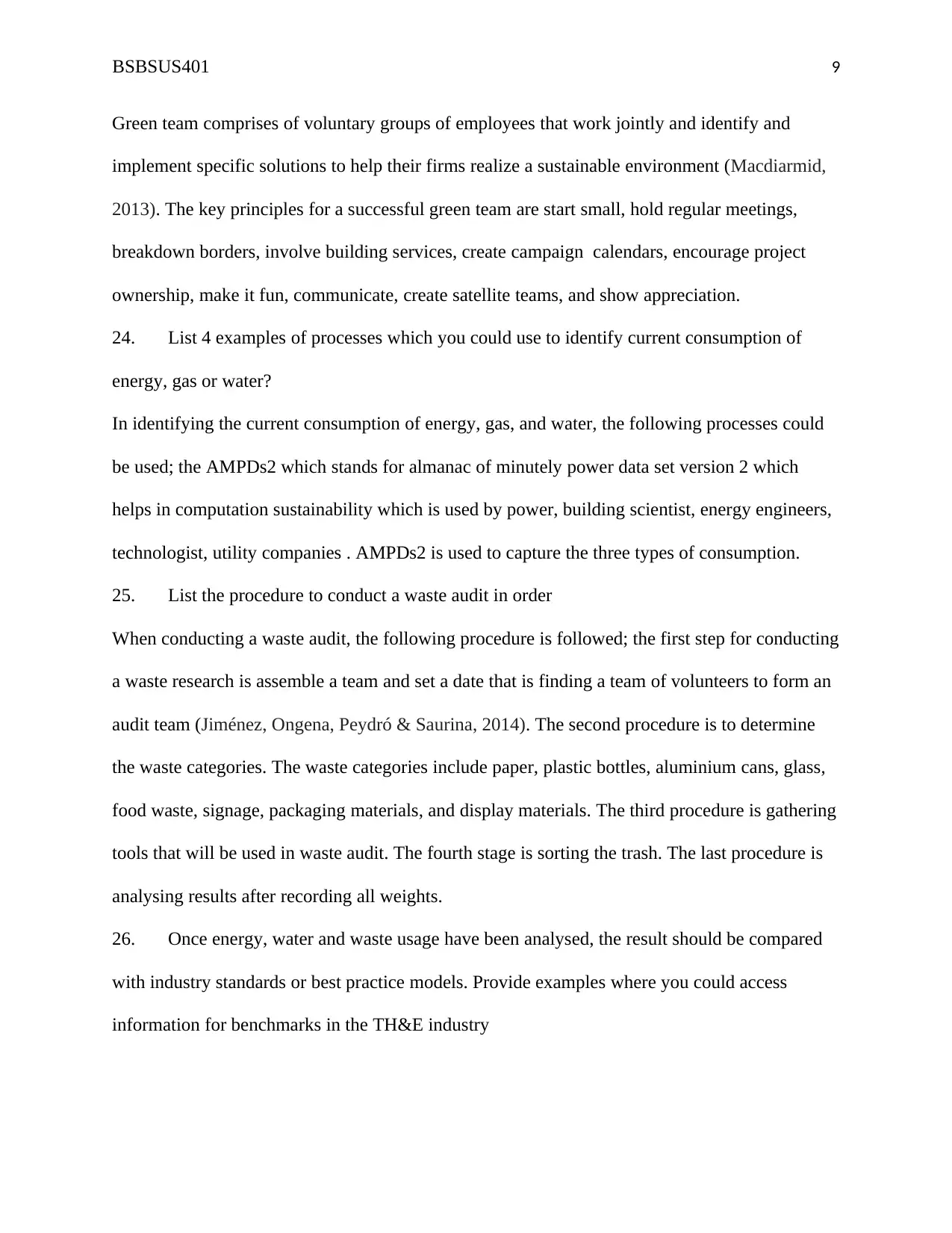
BSBSUS401 9
Green team comprises of voluntary groups of employees that work jointly and identify and
implement specific solutions to help their firms realize a sustainable environment (Macdiarmid,
2013). The key principles for a successful green team are start small, hold regular meetings,
breakdown borders, involve building services, create campaign calendars, encourage project
ownership, make it fun, communicate, create satellite teams, and show appreciation.
24. List 4 examples of processes which you could use to identify current consumption of
energy, gas or water?
In identifying the current consumption of energy, gas, and water, the following processes could
be used; the AMPDs2 which stands for almanac of minutely power data set version 2 which
helps in computation sustainability which is used by power, building scientist, energy engineers,
technologist, utility companies . AMPDs2 is used to capture the three types of consumption.
25. List the procedure to conduct a waste audit in order
When conducting a waste audit, the following procedure is followed; the first step for conducting
a waste research is assemble a team and set a date that is finding a team of volunteers to form an
audit team (Jiménez, Ongena, Peydró & Saurina, 2014). The second procedure is to determine
the waste categories. The waste categories include paper, plastic bottles, aluminium cans, glass,
food waste, signage, packaging materials, and display materials. The third procedure is gathering
tools that will be used in waste audit. The fourth stage is sorting the trash. The last procedure is
analysing results after recording all weights.
26. Once energy, water and waste usage have been analysed, the result should be compared
with industry standards or best practice models. Provide examples where you could access
information for benchmarks in the TH&E industry
Green team comprises of voluntary groups of employees that work jointly and identify and
implement specific solutions to help their firms realize a sustainable environment (Macdiarmid,
2013). The key principles for a successful green team are start small, hold regular meetings,
breakdown borders, involve building services, create campaign calendars, encourage project
ownership, make it fun, communicate, create satellite teams, and show appreciation.
24. List 4 examples of processes which you could use to identify current consumption of
energy, gas or water?
In identifying the current consumption of energy, gas, and water, the following processes could
be used; the AMPDs2 which stands for almanac of minutely power data set version 2 which
helps in computation sustainability which is used by power, building scientist, energy engineers,
technologist, utility companies . AMPDs2 is used to capture the three types of consumption.
25. List the procedure to conduct a waste audit in order
When conducting a waste audit, the following procedure is followed; the first step for conducting
a waste research is assemble a team and set a date that is finding a team of volunteers to form an
audit team (Jiménez, Ongena, Peydró & Saurina, 2014). The second procedure is to determine
the waste categories. The waste categories include paper, plastic bottles, aluminium cans, glass,
food waste, signage, packaging materials, and display materials. The third procedure is gathering
tools that will be used in waste audit. The fourth stage is sorting the trash. The last procedure is
analysing results after recording all weights.
26. Once energy, water and waste usage have been analysed, the result should be compared
with industry standards or best practice models. Provide examples where you could access
information for benchmarks in the TH&E industry
⊘ This is a preview!⊘
Do you want full access?
Subscribe today to unlock all pages.

Trusted by 1+ million students worldwide

BSBSUS401 10
In the TH&E industry, information for benchmarks can be found by speaking to the industry
association, using a commercial benchmarking business (Maitland & Sammartino, 2015).
Additionally, to access this information, the team involved in data analysis can do their own
benchmarking.
27. Efficiency targets should be set following the SMART principle. What does the Acronym
SMART stand for?
The acronym SMART stands for;
S- Specific
M- Measurable
A-Achievable
R- Relevant
T- time-oriented
28. Provide 4 suggestions for how staff can be actively involved in achieving improved
environmentally sustainable outcomes
For employees to be actively involved in achieving sustainability is through spelling out the
economic case of sustainability, encouraging healthy competition among staffs, and defining the
company’s long term purpose.
List 5 actions you might take if you observe a staff member acting in a non-compliant manner.
When an employee acts in a non-compliance manner, some of the actions that might be taken
against them include; first is the written reprimand which is appropriate when a staff ignores a
verbal warning regarding their behaviour. The second action may include a temporary pay cut
which takes place when a particular problem continues. Suspension is the other action that can be
In the TH&E industry, information for benchmarks can be found by speaking to the industry
association, using a commercial benchmarking business (Maitland & Sammartino, 2015).
Additionally, to access this information, the team involved in data analysis can do their own
benchmarking.
27. Efficiency targets should be set following the SMART principle. What does the Acronym
SMART stand for?
The acronym SMART stands for;
S- Specific
M- Measurable
A-Achievable
R- Relevant
T- time-oriented
28. Provide 4 suggestions for how staff can be actively involved in achieving improved
environmentally sustainable outcomes
For employees to be actively involved in achieving sustainability is through spelling out the
economic case of sustainability, encouraging healthy competition among staffs, and defining the
company’s long term purpose.
List 5 actions you might take if you observe a staff member acting in a non-compliant manner.
When an employee acts in a non-compliance manner, some of the actions that might be taken
against them include; first is the written reprimand which is appropriate when a staff ignores a
verbal warning regarding their behaviour. The second action may include a temporary pay cut
which takes place when a particular problem continues. Suspension is the other action that can be
Paraphrase This Document
Need a fresh take? Get an instant paraphrase of this document with our AI Paraphraser
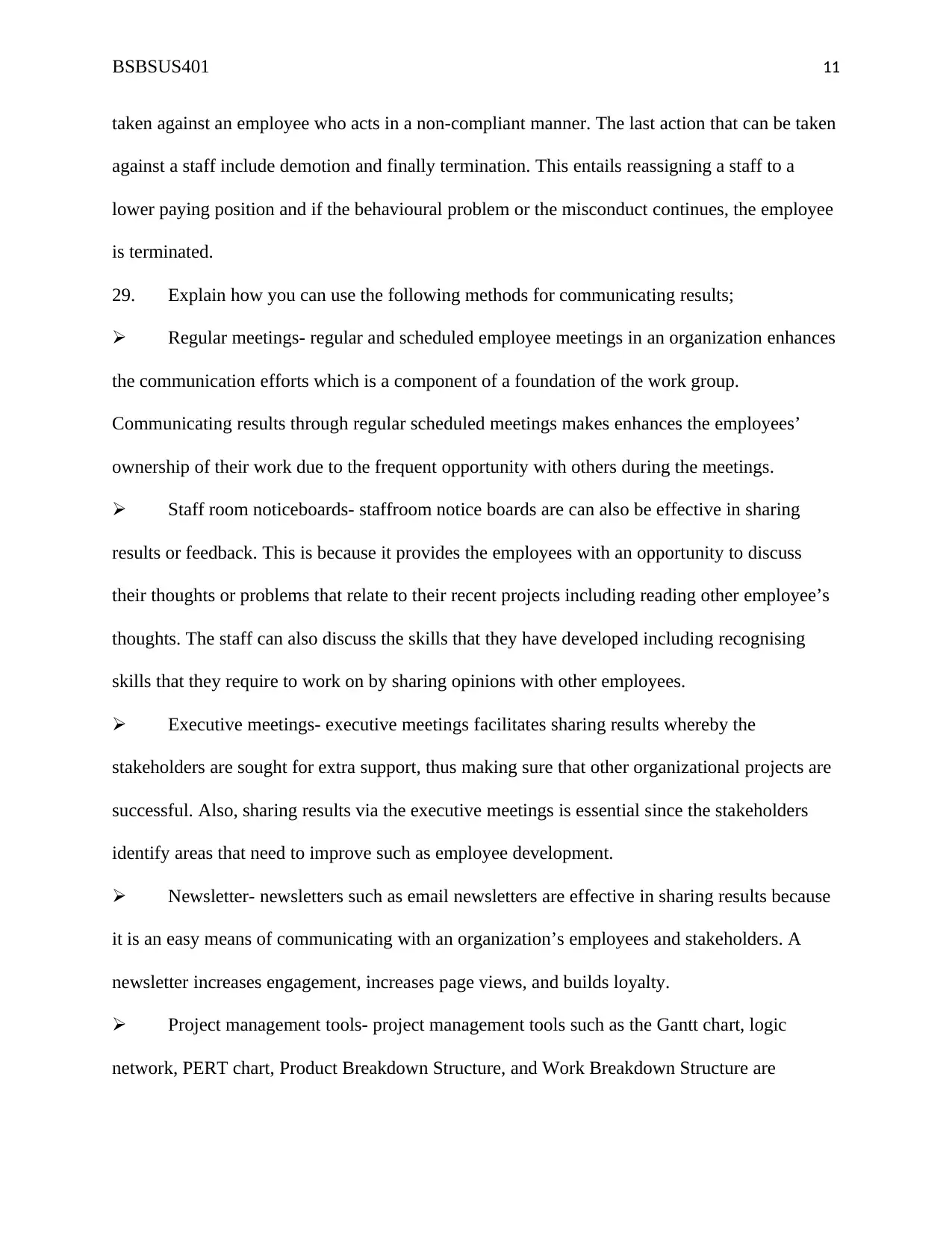
BSBSUS401 11
taken against an employee who acts in a non-compliant manner. The last action that can be taken
against a staff include demotion and finally termination. This entails reassigning a staff to a
lower paying position and if the behavioural problem or the misconduct continues, the employee
is terminated.
29. Explain how you can use the following methods for communicating results;
Regular meetings- regular and scheduled employee meetings in an organization enhances
the communication efforts which is a component of a foundation of the work group.
Communicating results through regular scheduled meetings makes enhances the employees’
ownership of their work due to the frequent opportunity with others during the meetings.
Staff room noticeboards- staffroom notice boards are can also be effective in sharing
results or feedback. This is because it provides the employees with an opportunity to discuss
their thoughts or problems that relate to their recent projects including reading other employee’s
thoughts. The staff can also discuss the skills that they have developed including recognising
skills that they require to work on by sharing opinions with other employees.
Executive meetings- executive meetings facilitates sharing results whereby the
stakeholders are sought for extra support, thus making sure that other organizational projects are
successful. Also, sharing results via the executive meetings is essential since the stakeholders
identify areas that need to improve such as employee development.
Newsletter- newsletters such as email newsletters are effective in sharing results because
it is an easy means of communicating with an organization’s employees and stakeholders. A
newsletter increases engagement, increases page views, and builds loyalty.
Project management tools- project management tools such as the Gantt chart, logic
network, PERT chart, Product Breakdown Structure, and Work Breakdown Structure are
taken against an employee who acts in a non-compliant manner. The last action that can be taken
against a staff include demotion and finally termination. This entails reassigning a staff to a
lower paying position and if the behavioural problem or the misconduct continues, the employee
is terminated.
29. Explain how you can use the following methods for communicating results;
Regular meetings- regular and scheduled employee meetings in an organization enhances
the communication efforts which is a component of a foundation of the work group.
Communicating results through regular scheduled meetings makes enhances the employees’
ownership of their work due to the frequent opportunity with others during the meetings.
Staff room noticeboards- staffroom notice boards are can also be effective in sharing
results or feedback. This is because it provides the employees with an opportunity to discuss
their thoughts or problems that relate to their recent projects including reading other employee’s
thoughts. The staff can also discuss the skills that they have developed including recognising
skills that they require to work on by sharing opinions with other employees.
Executive meetings- executive meetings facilitates sharing results whereby the
stakeholders are sought for extra support, thus making sure that other organizational projects are
successful. Also, sharing results via the executive meetings is essential since the stakeholders
identify areas that need to improve such as employee development.
Newsletter- newsletters such as email newsletters are effective in sharing results because
it is an easy means of communicating with an organization’s employees and stakeholders. A
newsletter increases engagement, increases page views, and builds loyalty.
Project management tools- project management tools such as the Gantt chart, logic
network, PERT chart, Product Breakdown Structure, and Work Breakdown Structure are
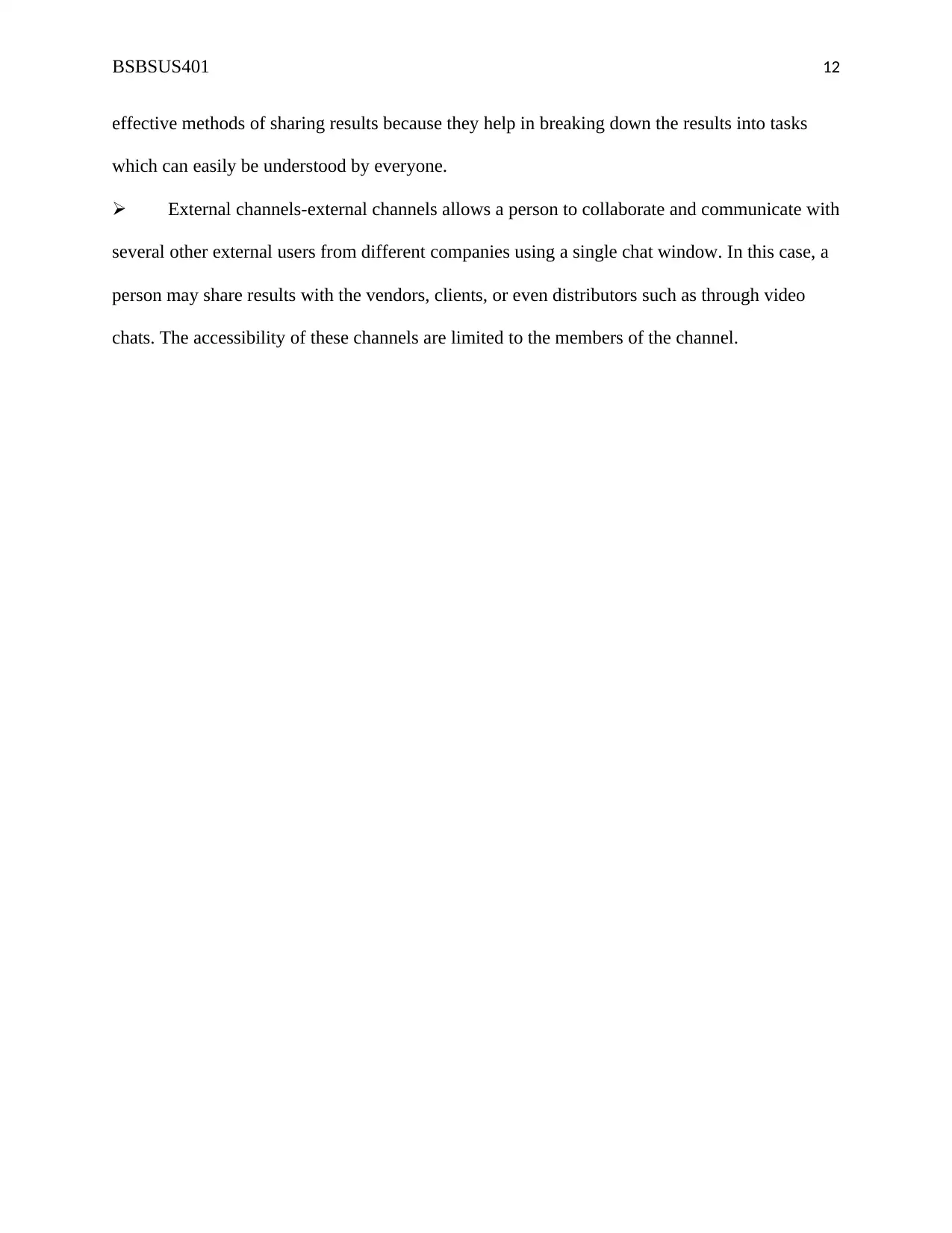
BSBSUS401 12
effective methods of sharing results because they help in breaking down the results into tasks
which can easily be understood by everyone.
External channels-external channels allows a person to collaborate and communicate with
several other external users from different companies using a single chat window. In this case, a
person may share results with the vendors, clients, or even distributors such as through video
chats. The accessibility of these channels are limited to the members of the channel.
effective methods of sharing results because they help in breaking down the results into tasks
which can easily be understood by everyone.
External channels-external channels allows a person to collaborate and communicate with
several other external users from different companies using a single chat window. In this case, a
person may share results with the vendors, clients, or even distributors such as through video
chats. The accessibility of these channels are limited to the members of the channel.
⊘ This is a preview!⊘
Do you want full access?
Subscribe today to unlock all pages.

Trusted by 1+ million students worldwide
1 out of 14
Related Documents
Your All-in-One AI-Powered Toolkit for Academic Success.
+13062052269
info@desklib.com
Available 24*7 on WhatsApp / Email
![[object Object]](/_next/static/media/star-bottom.7253800d.svg)
Unlock your academic potential
Copyright © 2020–2025 A2Z Services. All Rights Reserved. Developed and managed by ZUCOL.





